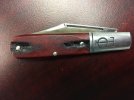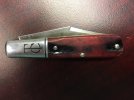- Joined
- May 23, 2013
- Messages
- 13,444
Q. What Makes a Good, Traditional Barlow?
A. A Barlow made at WilfredWorks in a traditional way, with a little modern steel thrown in!
View attachment 811726 View attachment 811727
Absolutely fantastic! That old bone about brings me to tears every time.










